Alfa Romeo Giulietta 2014 Owner's Manual
Manufacturer: ALFA ROMEO, Model Year: 2014, Model line: Giulietta, Model: Alfa Romeo Giulietta 2014Pages: 280, PDF Size: 6.65 MB
Page 141 of 280
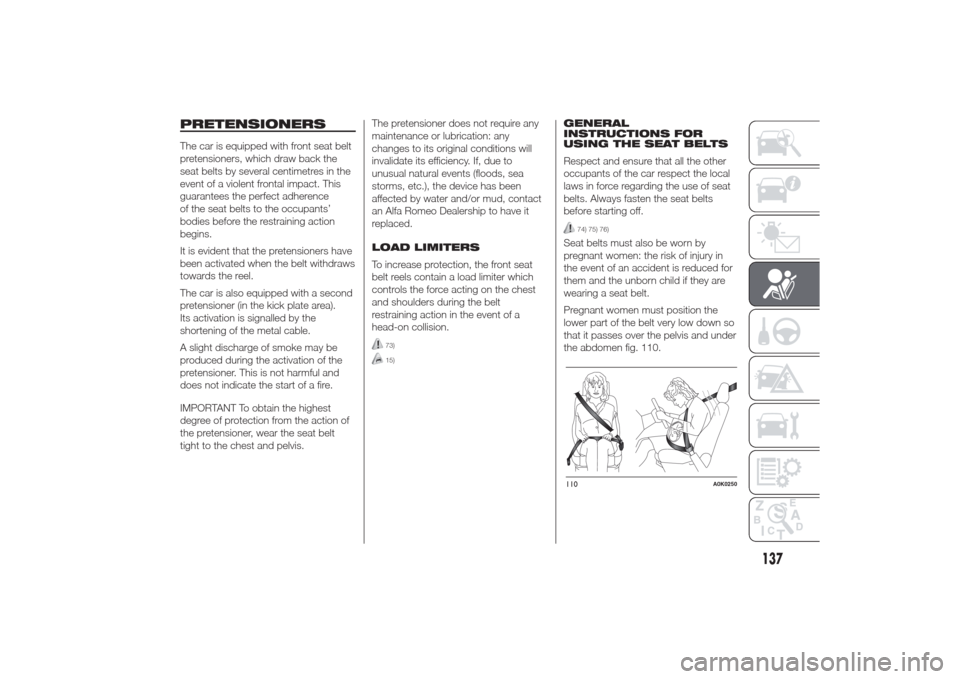
PRETENSIONERSThe car is equipped with front seat belt
pretensioners, which draw back the
seat belts by several centimetres in the
event of a violent frontal impact. This
guarantees the perfect adherence
of the seat belts to the occupants’
bodies before the restraining action
begins.
It is evident that the pretensioners have
been activated when the belt withdraws
towards the reel.
The car is also equipped with a second
pretensioner (in the kick plate area).
Its activation is signalled by the
shortening of the metal cable.
A slight discharge of smoke may be
produced during the activation of the
pretensioner. This is not harmful and
does not indicate the start of a fire.
IMPORTANT To obtain the highest
degree of protection from the action of
the pretensioner, wear the seat belt
tight to the chest and pelvis.The pretensioner does not require any
maintenance or lubrication: any
changes to its original conditions will
invalidate its efficiency. If, due to
unusual natural events (floods, sea
storms, etc.), the device has been
affected by water and/or mud, contact
an Alfa Romeo Dealership to have it
replaced.
LOAD LIMITERS
To increase protection, the front seat
belt reels contain a load limiter which
controls the force acting on the chest
and shoulders during the belt
restraining action in the event of a
head-on collision.
73)15)
GENERAL
INSTRUCTIONS FOR
USING THE SEAT BELTS
Respect and ensure that all the other
occupants of the car respect the local
laws in force regarding the use of seat
belts. Always fasten the seat belts
before starting off.
74) 75) 76)
Seat belts must also be worn by
pregnant women: the risk of injury in
the event of an accident is reduced for
them and the unborn child if they are
wearing a seat belt.
Pregnant women must position the
lower part of the belt very low down so
that it passes over the pelvis and under
the abdomen fig. 110.110
A0K0250
137
Page 142 of 280
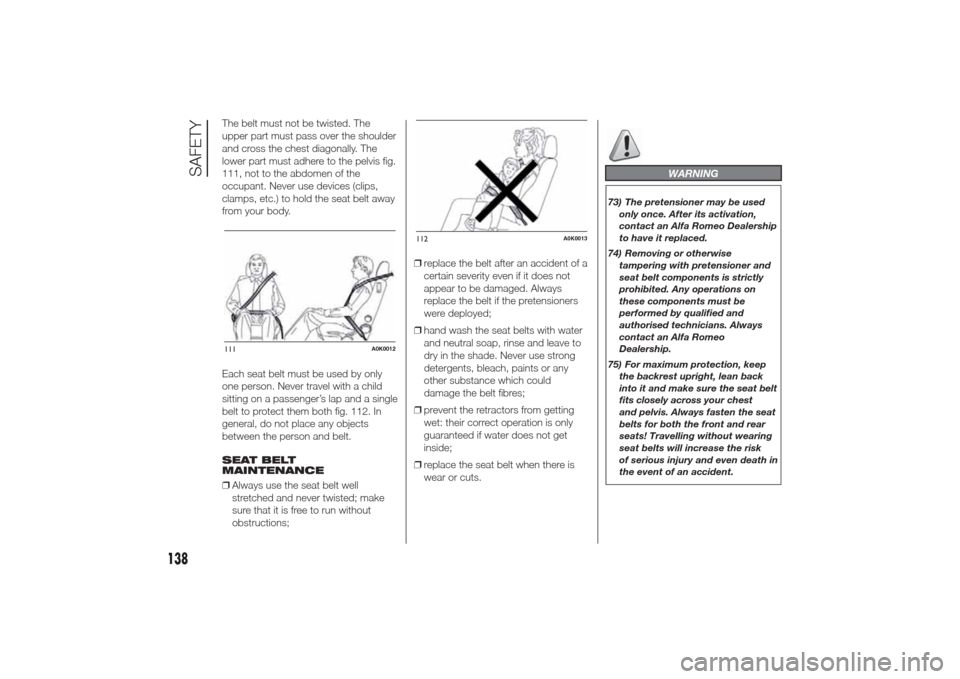
The belt must not be twisted. The
upper part must pass over the shoulder
and cross the chest diagonally. The
lower part must adhere to the pelvis fig.
111, not to the abdomen of the
occupant. Never use devices (clips,
clamps, etc.) to hold the seat belt away
from your body.
Each seat belt must be used by only
one person. Never travel with a child
sitting on a passenger’s lap and a single
belt to protect them both fig. 112. In
general, do not place any objects
between the person and belt.
SEAT BELT
MAINTENANCE
❒Always use the seat belt well
stretched and never twisted; make
sure that it is free to run without
obstructions;❒replace the belt after an accident of a
certain severity even if it does not
appear to be damaged. Always
replace the belt if the pretensioners
were deployed;
❒hand wash the seat belts with water
and neutral soap, rinse and leave to
dry in the shade. Never use strong
detergents, bleach, paints or any
other substance which could
damage the belt fibres;
❒prevent the retractors from getting
wet: their correct operation is only
guaranteed if water does not get
inside;
❒replace the seat belt when there is
wear or cuts.
WARNING
73) The pretensioner may be used
only once. After its activation,
contact an Alfa Romeo Dealership
to have it replaced.
74) Removing or otherwise
tampering with pretensioner and
seat belt components is strictly
prohibited. Any operations on
these components must be
performed by qualified and
authorised technicians. Always
contact an Alfa Romeo
Dealership.
75) For maximum protection, keep
the backrest upright, lean back
into it and make sure the seat belt
fits closely across your chest
and pelvis. Always fasten the seat
belts for both the front and rear
seats! Travelling without wearing
seat belts will increase the risk
of serious injury and even death in
the event of an accident.
111
A0K0012
112
A0K0013
138
SAFETY
Page 143 of 280
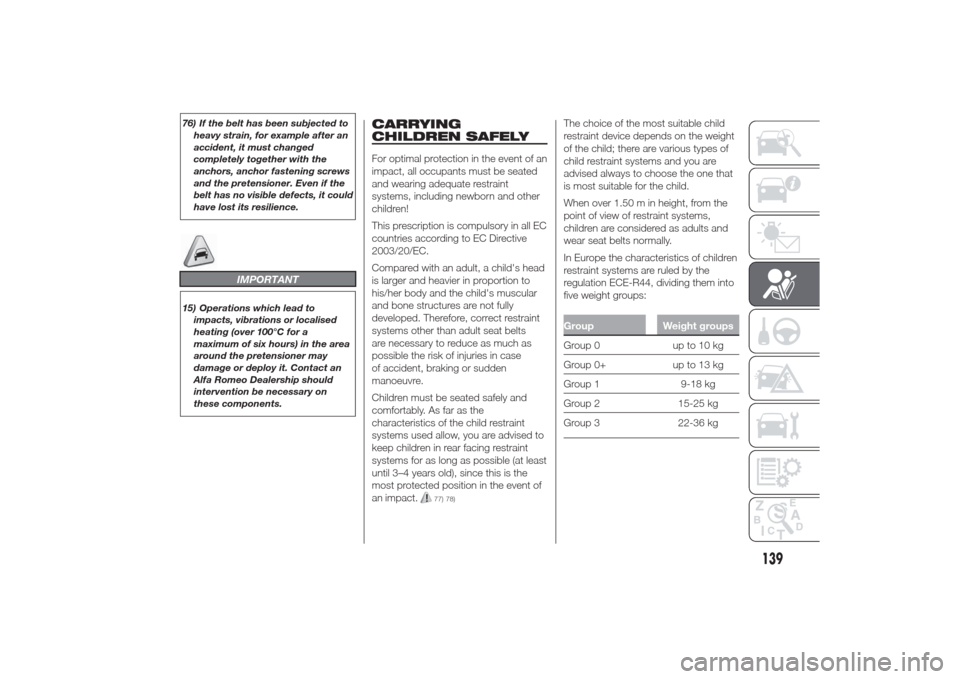
76) If the belt has been subjected to
heavy strain, for example after an
accident, it must changed
completely together with the
anchors, anchor fastening screws
and the pretensioner. Even if the
belt has no visible defects, it could
have lost its resilience.
IMPORTANT
15) Operations which lead to
impacts, vibrations or localised
heating (over 100°C for a
maximum of six hours) in the area
around the pretensioner may
damage or deploy it. Contact an
Alfa Romeo Dealership should
intervention be necessary on
these components.
CARRYING
CHILDREN SAFELYFor optimal protection in the event of an
impact, all occupants must be seated
and wearing adequate restraint
systems, including newborn and other
children!
This prescription is compulsory in all EC
countries according to EC Directive
2003/20/EC.
Compared with an adult, a child's head
is larger and heavier in proportion to
his/her body and the child's muscular
and bone structures are not fully
developed. Therefore, correct restraint
systems other than adult seat belts
are necessary to reduce as much as
possible the risk of injuries in case
of accident, braking or sudden
manoeuvre.
Children must be seated safely and
comfortably. As far as the
characteristics of the child restraint
systems used allow, you are advised to
keep children in rear facing restraint
systems for as long as possible (at least
until 3–4 years old), since this is the
most protected position in the event of
an impact.
77) 78)
The choice of the most suitable child
restraint device depends on the weight
of the child; there are various types of
child restraint systems and you are
advised always to choose the one that
is most suitable for the child.
When over 1.50 m in height, from the
point of view of restraint systems,
children are considered as adults and
wear seat belts normally.
In Europe the characteristics of children
restraint systems are ruled by the
regulation ECE-R44, dividing them into
five weight groups:Group Weight groupsGroup0 upto10kg
Group 0+ up to 13 kg
Group 1 9-18 kg
Group 2 15-25 kg
Group 3 22-36 kg
139
Page 144 of 280
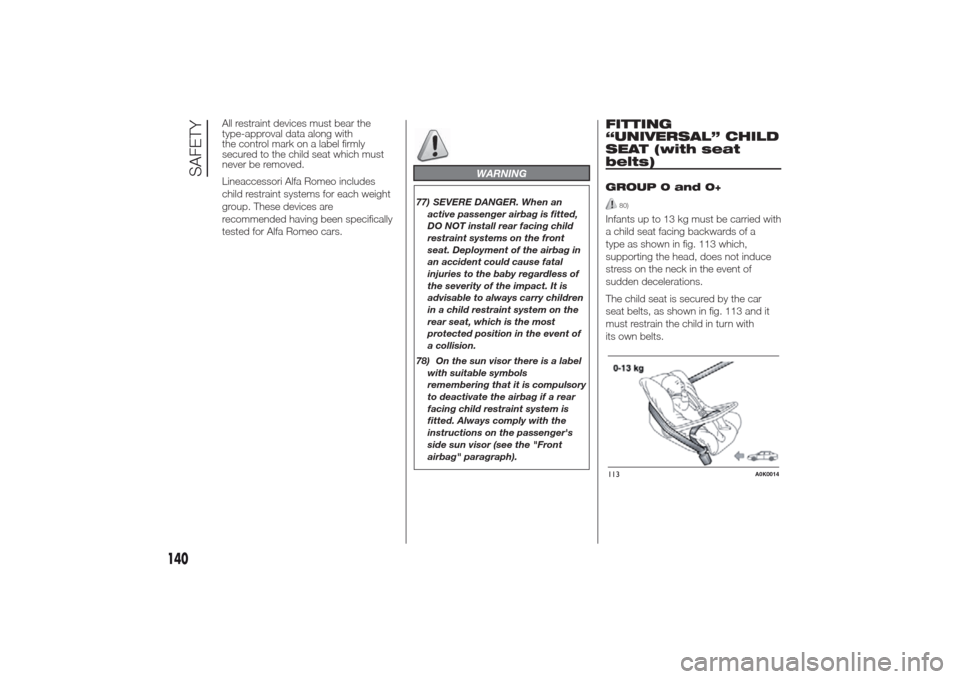
All restraint devices must bear the
type-approval data along with
the control mark on a label firmly
secured to the child seat which must
never be removed.
Lineaccessori Alfa Romeo includes
child restraint systems for each weight
group. These devices are
recommended having been specifically
tested for Alfa Romeo cars.
WARNING
77) SEVERE DANGER. When an
active passenger airbag is fitted,
DO NOT install rear facing child
restraint systems on the front
seat. Deployment of the airbag in
an accident could cause fatal
injuries to the baby regardless of
the severity of the impact. It is
advisable to always carry children
in a child restraint system on the
rear seat, which is the most
protected position in the event of
a collision.
78) On the sun visor there is a label
with suitable symbols
remembering that it is compulsory
to deactivate the airbag if a rear
facing child restraint system is
fitted. Always comply with the
instructions on the passenger's
side sun visor (see the "Front
airbag" paragraph).
FITTING
“UNIVERSAL” CHILD
SEAT (with seat
belts)GROUP 0 and 0+
80)
Infants up to 13 kg must be carried with
a child seat facing backwards of a
type as shown in fig. 113 which,
supporting the head, does not induce
stress on the neck in the event of
sudden decelerations.
The child seat is secured by the car
seat belts, as shown in fig. 113 and it
must restrain the child in turn with
its own belts.113
A0K0014
140
SAFETY
Page 145 of 280

GROUP 1
79) 80)
Children of weight from 9 to 18 kg may
be carried in child seats facing forwards
fig. 114.
GROUP 2
80)
Children from 15 to 25 kg may use the
car seat belts directly fig. 115.In this case, the child restraint system is
used to position the child correctly
with respect to the seat belts so that
the diagonal belt section crosses the
child’s chest and not the neck, and the
lower part is snug on the pelvis not
the abdomen.
GROUP 3
80)
For children between 22 kg and 36 kg,
there are dedicated restraint systems
that allow the seat belt to be worn
correctly.
fig. 116 shows an example of correct
child seat positioning on the rear seat.
Children over 1.50 m in height can wear
seat belts like adults.
WARNING
79) Child restraint systems with
Isofix attachments are available,
which allow them to be secured to
the seat safely without using the
car seat belts. See paragraph
"Isofix child restraint system
setup" for the fitting instructions.
80) The figure is indicative for fitting
purposes only. Fit the child
restraint system according to the
instructions, which must be
included.
114
A0K0129
115
A0K0016
116
A0K0017
141
Page 146 of 280
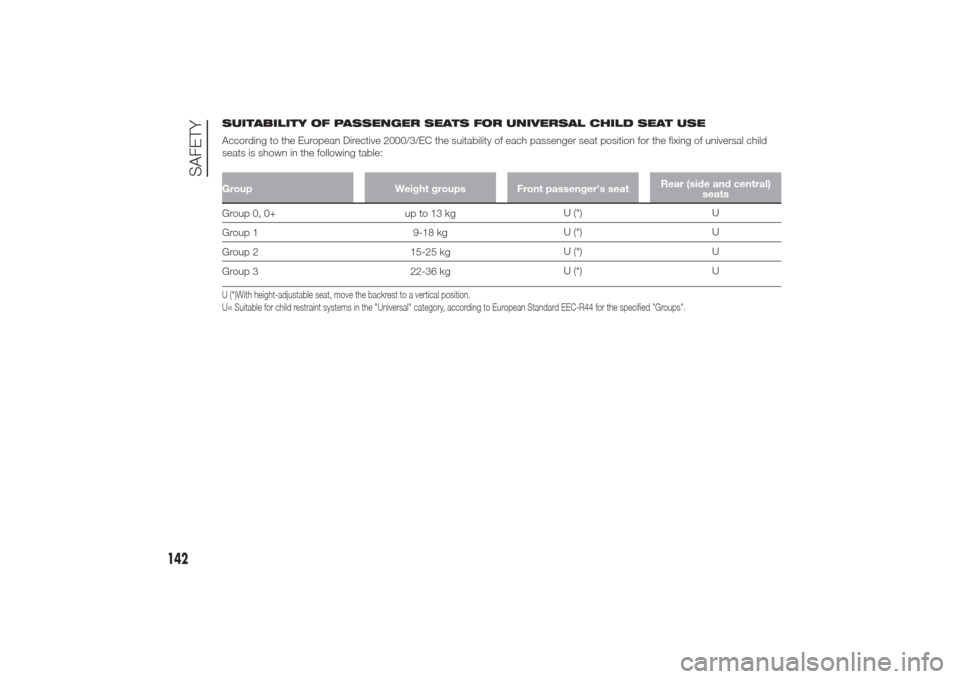
SUITABILITY OF PASSENGER SEATS FOR UNIVERSAL CHILD SEAT USE
According to the European Directive 2000/3/EC the suitability of each passenger seat position for the fixing of universal child
seats is shown in the following table:Group Weight groups Front passenger's seatRear (side and central)
seatsGroup 0, 0+ up to 13 kgU (*) U
Group 1 9-18 kgU (*) U
Group 2 15-25 kgU (*) U
Group 3 22-36 kgU (*) UU (*)With height-adjustable seat, move the backrest to a vertical position.
U= Suitable for child restraint systems in the "Universal" category, according to European Standard EEC-R44 for the specified "Groups".
142
SAFETY
Page 147 of 280
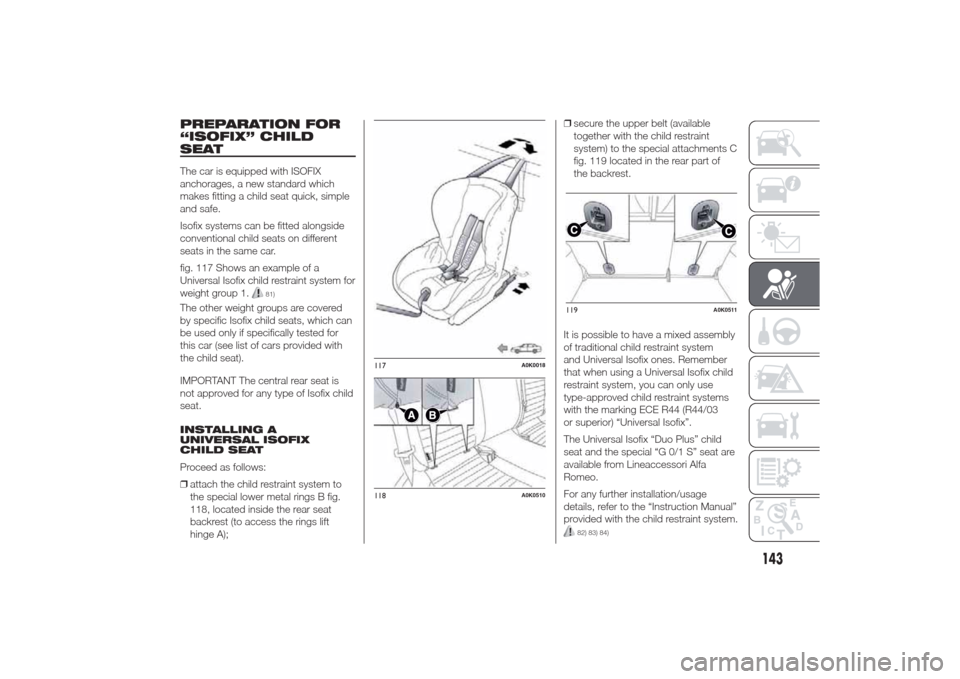
PREPARATION FOR
“ISOFIX” CHILD
SEATThe car is equipped with ISOFIX
anchorages, a new standard which
makes fitting a child seat quick, simple
and safe.
Isofix systems can be fitted alongside
conventional child seats on different
seats in the same car.
fig. 117 Shows an example of a
Universal Isofix child restraint system for
weight group 1.
81)
The other weight groups are covered
by specific Isofix child seats, which can
be used only if specifically tested for
this car (see list of cars provided with
the child seat).
IMPORTANT The central rear seat is
not approved for any type of Isofix child
seat.
INSTALLING A
UNIVERSAL ISOFIX
CHILD SEAT
Proceed as follows:
❒attach the child restraint system to
the special lower metal rings B fig.
118, located inside the rear seat
backrest (to access the rings lift
hinge A);❒secure the upper belt (available
together with the child restraint
system) to the special attachments C
fig. 119 located in the rear part of
the backrest.
It is possible to have a mixed assembly
of traditional child restraint system
and Universal Isofix ones. Remember
that when using a Universal Isofix child
restraint system, you can only use
type-approved child restraint systems
with the marking ECE R44 (R44/03
or superior) “Universal Isofix”.
The Universal Isofix “Duo Plus” child
seat and the special “G 0/1 S” seat are
available from Lineaccessori Alfa
Romeo.
For any further installation/usage
details, refer to the “Instruction Manual”
provided with the child restraint system.
82) 83) 84)
117
A0K0018
118
A0K0510
119
A0K0511
143
Page 148 of 280

SUITABILITY OF PASSENGER SEATS FOR ISOFIX CHILD SEAT USE
The table below shows the various installation possibilities for Isofix child seats on seats fitted with Isofix attachments in
accordance with European standard ECE 16.Weight groupChild restraint system
positionIsofix size class Rear side seatsGroup 0 up to 10 kg Facing backwards EIL (*)
Group 0+ up to 13 kgFacing backwards EIL (*)
Facing backwards DIL (*)
Facing backwards CIL (*)
Group1from9upto18kgFacing backwards DIL (*)
Facing backwards CIL (*)
Forward facing BIUF
Forward facing BIIUF
Forward facing AIUFIL suitable for ISOFIX child restraint systems of the categories for "specific vehicles", "restricted" or "semiuniversal"
(*) the Isofix child seat can be installed by adjusting the front seat
IUF: suitable for Isofix child seats to be positioned in forward facing position, universal class (fitted with third upper mounting), type-approvedfor the relevant weight
group.
144
SAFETY
Page 149 of 280

Main recommendations
to carry children safely
❒Install the child restraint systems
on the rear seat, which is the most
protected position in the event of an
accident.
❒Keep children in rear facing child
restraint systems for as long as
possible, until 2 years old.
❒Should a rear facing child restraint
system be installed on the rear seats,
it is advisable to position it as far
forward as the position of the front
seat allows.
❒If the front passenger airbag is
deactivated always check the
permanent switching on of the
warning light in the trim above the
internal rearview mirror to make
sure that it has actually been
deactivated.
❒Carefully follow the instructions
supplied with the child restraint
system itself. Keep the instructions in
the car along with the other
documents and this handbook. Do
not use second-hand child restraint
systems without instructions.
❒Only one child is to be strapped into
each restraint system; never carry
two children simultaneously.❒Always check that the seat belts do
not interfere with the child's throat.
❒Always check that the seat belt
is well fastened by pulling on it.
❒While travelling, do not let the child sit
incorrectly or unfasten the belts.
❒Never allow a child to put the belt's
diagonal section under an arm or
behind their back.
❒Never carry children on your lap,
even newborns. No-one can restrain
a child in the event of an accident.
❒In the event of an accident, replace
the child restraint system with a
new one.
WARNING
81) The figure is indicative for fitting
purposes only. Fit the child
restraint system according to the
instructions, which must be
included.
82) If a Universal Isofix child
restraint system is not fixed to all
three anchorages, it will not be
able to protect the child correctly.
In a crash, the child could be
seriously or fatally injured.83) Fit the child restraint system only
when the car is stationary. The
child restraint system is correctly
secured to the brackets when
you hear the click. Follow the
instructions for assembly,
disassembly and positioning that
the manufacturer must supply
with the child restraint system.
84) Fit the child restraint system
according to the instructions,
which must be included.
145
Page 150 of 280
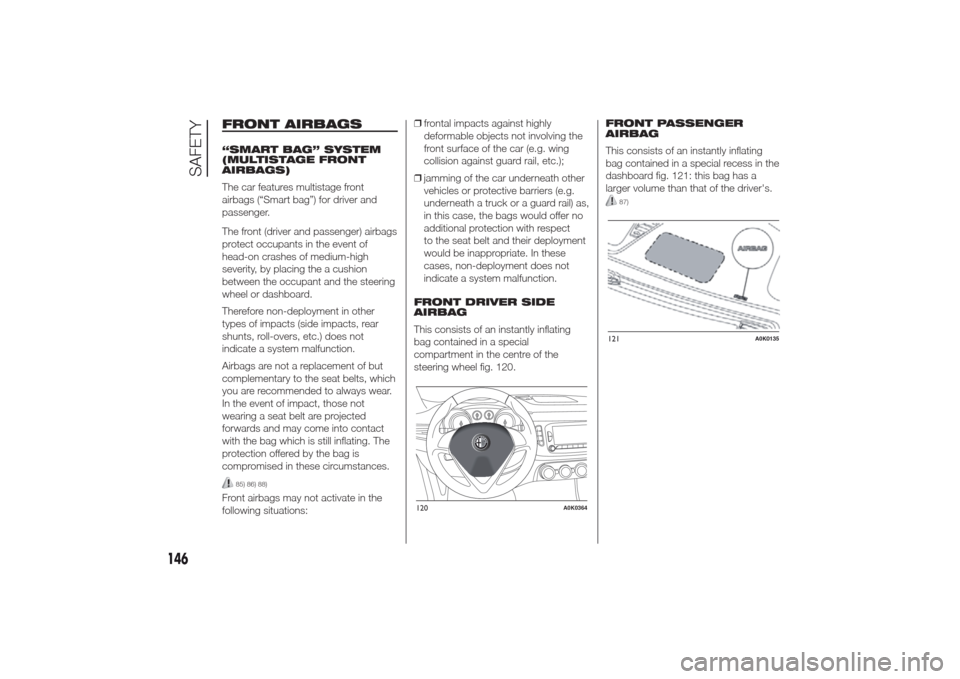
FRONT AIRBAGS“SMART BAG” SYSTEM
(MULTISTAGE FRONT
AIRBAGS)
The car features multistage front
airbags (“Smart bag”) for driver and
passenger.
The front (driver and passenger) airbags
protect occupants in the event of
head-on crashes of medium-high
severity, by placing the a cushion
between the occupant and the steering
wheel or dashboard.
Therefore non-deployment in other
types of impacts (side impacts, rear
shunts, roll-overs, etc.) does not
indicate a system malfunction.
Airbags are not a replacement of but
complementary to the seat belts, which
you are recommended to always wear.
In the event of impact, those not
wearing a seat belt are projected
forwards and may come into contact
with the bag which is still inflating. The
protection offered by the bag is
compromised in these circumstances.
85) 86) 88)
Front airbags may not activate in the
following situations:❒frontal impacts against highly
deformable objects not involving the
front surface of the car (e.g. wing
collision against guard rail, etc.);
❒jamming of the car underneath other
vehicles or protective barriers (e.g.
underneath a truck or a guard rail) as,
in this case, the bags would offer no
additional protection with respect
to the seat belt and their deployment
would be inappropriate. In these
cases, non-deployment does not
indicate a system malfunction.
FRONT DRIVER SIDE
AIRBAG
This consists of an instantly inflating
bag contained in a special
compartment in the centre of the
steering wheel fig. 120.FRONT PASSENGER
AIRBAG
This consists of an instantly inflating
bag contained in a special recess in the
dashboard fig. 121: this bag has a
larger volume than that of the driver's.
87)
120
A0K0364
121
A0K0135
146
SAFETY